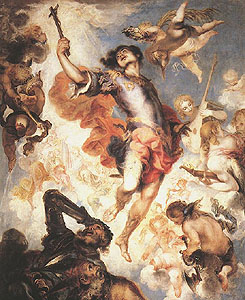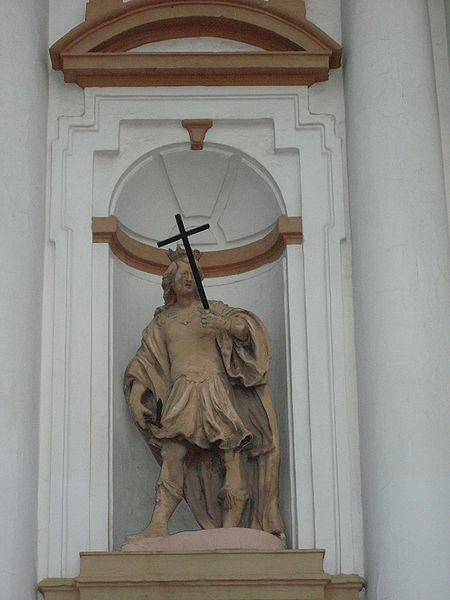St. Hermengild
Date of birth unknown; died 13 April, 585.

Detail from ‘The Triumph of Hermengild’, by Francisco de Herrera the Younger, 1622-1685, oil on canvas, Museo del Prado, Madrid, Spain
Leovigild, the Arian King of the Visigoths (569-86), had two sons, Hermengild and Reccared, by his first marriage with the Catholic Princess Theodosia.
Hermengild married, in 576, Ingundis, a Frankish Catholic princess, the daughter of Sigebert and Brunhilde. Led by his own inclination, and influenced by his wife as well as by the instructions of St. Leander of Seville, he entered the Catholic fold.
Leovigild’s second wife, Goswintha, a fanatical Arian, hated her daughter-in-law and sought by ill-treatment to force her to abandon the Catholic Faith. Hermengild had accordingly withdrawn, with his father’s sanction, to Andalusia, and had taken his wife with him. But when Leovigild learned of his son’s conversion he summoned him back to Toledo, which command Hermengild did not obey.
The fanatical Arianism of his step-mother, and his father’s severe treatment of Catholics in Spain, stirred him to take up arms in protection of his oppressed co-religionists and in defence of his own rights. At the same time he formed an alliance with the Byzantines. Leovigold took the field against his son in 582, prevailed on the Byzantines to betray Hermengild for a sum of 30,000 gold solidi, besieged the latter in Seville in 583, and captured the city after a siege of nearly two years.
Hermengild sought refuge in a church at Cordova, whence he was enticed by the false promises of Leovigild, who stripped him in camp of his royal raiment and banished him to Valencia (584). His wife, Ingundis, fled with her son to Africa, where she died, after which the boy was given, by order of Emperor Mauritius, into the hands of his grandmother Brunhilde. We are not fully informed as to Hermengild’s subsequent fate.
Gregory the Great relates (Dialogi, III, 31, in P.L. LXVII, 289-93) that Leovigild sent an Arian bishop to him in his prison, on Easter Eve of 585, with a promise that he would forgive him all, provided he consented to receive Holy Communion from the hands of this bishop. But Hermengild firmly refused thus to abjure his Catholic belief, and was in consequence beheaded on Easter Day. He was later venerated as a martyr, and Sixtus V (1585), acting on the suggestion of King Philip II, extended the celebration of his feast (13 April) throughout the whole of Spain.
Acta SS., April, II, 134-138; GAMS, Kirchengeschichte Spaniens, II (Ratisbon, 1864), i, 489 sqq.; II (1874), ii, 1 sqq.; GÖRRES, Hermengild in Zetschrift für historische Theologie, 1873, 1-109; LECLERCQ, L’Espagne chrétienne (Paris, 1906), 254 sqq.
J.P. KIRSCH (Catholic Encyclopedia)







